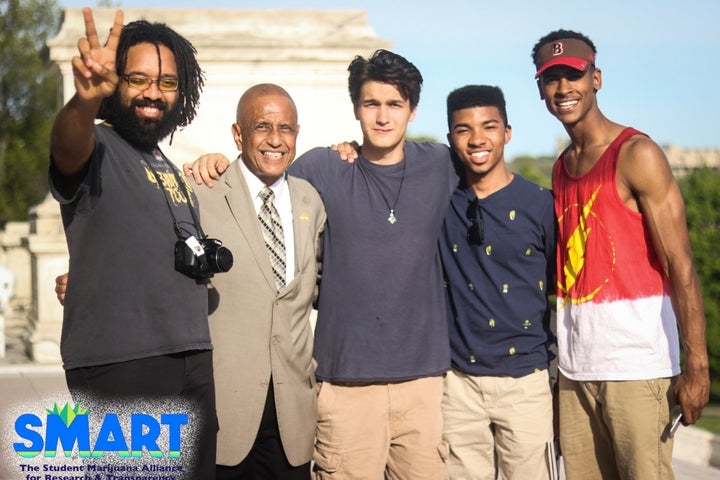This post originally appeared on The Well, Jopwell’s digital magazine and is by Brown University student Nadir Pearson.

Nadir Pearson (R) and his SMART team at the Rhode Island Legalization Rally
Marijuana is dangerous.
Marijuana is a gateway drug.
Using marijuana will leave you a deadbeat.
These are just a few of the myths I’ve heard over and over again when it comes to the most commonly used, still-illicit substance in the United States. And this misinformation is at the core of why I founded the Student Marijuana Alliance for Research & Transparency (SMART) at Brown University this fall.
SMART includes ‘marijuana’ in our title because, as we begin to progress and realize the truth in cannabis, we cannot forget the longstanding history and fear caused by the term marijuana. Prior to the 1920s, Cannabis sativa was a legal and frequently used medicine. The label marijuana was popularized later when an influx of Mexican immigrants allegedly introduced smoking the herb to Americans. Propaganda in news and media utilized this word to create a fearful image of cannabis users and immigrants. Americans racialized marijuana, associating it with criminal stereotypes of Mexicans and eventually Black people. Thus, the scientific name Cannabis sativa has been wiped from our collective memory.
SMART aims to encourage education, research, activism, and entrepreneurship within the cannabis industry, all while setting a precedent for how college communities can contribute to the global discussion about cannabis. SMART works in alliance with experts, Brown alumni, and young entrepreneurs in the industry to spread information beyond our campus.
So why is this all such a big deal? From 2013 to 2016, the number of adults who say they currently use marijuana has nearly doubled (and these figures are likely underreported). There’s huge potential to correct misconceptions, build businesses, and enact positive change in this realm, so long as we keep these five things in mind.
1. The D.A.R.E America program misled us.
I, like many of my peers, was taught in school by police officers and D.A.R.E. (Drug Abuse Resistance Education) America that marijuana was an incredibly dangerous substance. Imagine my surprise when I later found out that you are 114 times more likely to die from overdosing on alcohol than marijuana. In fact, no one, not a single person, has ever died from a marijuana overdose. That figure stands in stark contrast to the thousands of people who pass away every year due to the abuse of normalized substances like alcohol and the effects of the opioid epidemic. Marijuana is not even a physically addictive substance like alcohol, tobacco, or caffeine which are all legal substances that will cause crippling withdrawal symptoms. Ironically, for people who have fallen victim to prescription painkiller addiction, marijuana has been the exit rather than the gateway drug we have long feared it to be.
2. Cannabis can help people.
Medical marijuana is currently legal in 29 states and Washington D.C., so it’s likely you’ve heard about the cannabis plant’s health benefits. Countless studies have found it to be effective in treating chronic pain, mental illness, seizures, nausea associated with chemotherapy, and more. But that’s not the only way cannabis helps people. Hemp, a Cannabis sativa plant that contains less than 0.3 percent THC, is actually an agricultural crop. Historically, its fibers have been used to build textiles and as fuels. In fact, hemp has the potential to become a biofuel of the future, meaning it could significantly reduce our dependence on environmentally hazardous fossil fuels.
3. It's a fixture of our unequal prison system.
According to the Drug Policy Alliance, 1.49 million people were arrested for drug law violations in 2015. Forty-three percent of these arrests were for marijuana use, and, of those 43 percent, 87 percent were charged for possession only (not selling). Add that to the fact that, per the ACLU, between 2001 and 2010, Blacks were nearly four times more likely than Whites to be arrested for marijuana possession. When you look at these numbers, it’s no wonder that one in nine Black children has an incarcerated parent — far more than the one in 28 Latino children or one in 57 White children that experience the same.
Especially in professional settings, I can’t help but notice the absence of Black and Brown faces like my own. It’s made me realize that too many Black people who belong in these spaces are in prison. Hundreds of thousands, very possibly, even millions of people that look just like me have had their futures dismantled for the recreational use of the same plant we increasingly see White men making millions from.
4. It belongs in academic settings.
I’m lucky that Brown has long been recognized for its willingness to bring scholarly excellence into areas of inquiry that society may consider taboo. Because of this, my experience getting SMART approved was no different than that of any other student organization founder. I drafted our constitution detailing our mission, goals, and the actionable steps we will take to foster an innovative college cannabis community. I emphasized our commitment to educating millennials about the cannabis industry. By changing the way cannabis is spoken about on campus, young intelligent minds will begin to unlock the innovative potential lying within cannabis. And, by introducing others to a variety of people with experiences that contradict the lazy stoner stereotype, we can help rectify cannabis’ negative public image. Add that to the fact that academic institutions are uniquely poised to perform groundbreaking research to inform the future of cannabis use and the cannabis industry, and it’s tough to argue that this isn’t an issue in which schools should be involved.
5. There's no better generation to drive this soon-to-be $21 billion industry.
In 2015, the national cannabis market was worth $5.7 billion. In 2016, it totaled $6.7 billion. And in 2020? We’re look at a projected $21 billion, according to New Frontier Data and Arcview Group. By 2020, legal cannabis could create almost 300,000 jobs. Needless to say, there’s a whole lot of opportunity.
In educating my peers about cannabis, I’ve been incredibly excited to usher in a new era of understanding. For many students, the health benefits are the most moving; others are captivated by the economic potential. Regardless, there is something for everyone in cannabis, and it’s been extremely rewarding to show students that their skills are valued in the industry. Millennials are more than capable of driving innovation. We must realize that, even though we’re young, we can get it done.
